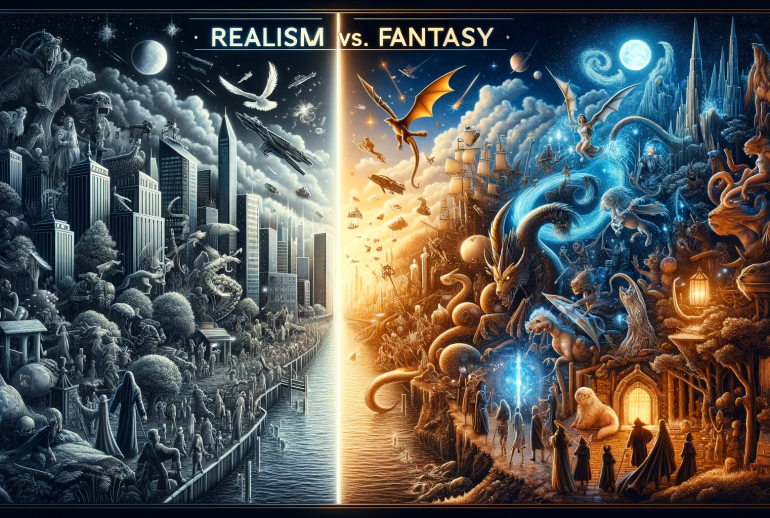In the realm of storytelling, authors have the power to transport readers to worlds of their own creation. Within these imaginative landscapes, a pivotal decision arises: the choice between realism and fantasy. While some stories thrive on the gritty authenticity of the real world, others soar into the realm of magic and wonder. Striking the right balance between the two is an art that can determine the success of a narrative. In this exploration, we delve into the delicate dance of realism and fantasy in fiction, deciphering the factors that guide authors in crafting worlds that captivate and resonate with readers.
The Spectrum of Realism and Fantasy
Before we delve into the intricacies of striking the right balance, it’s essential to understand the spectrum along which realism and fantasy exist:
Realism-Centered: Stories grounded in realism mirror our everyday world. They focus on accurate portrayals of human behavior, natural laws, and the limitations of the real world. Examples include literary fiction and historical novels.
Fantasy-Centered: In contrast, fantasy worlds are unbound by the laws of reality. They introduce elements like magic, mythical creatures, and supernatural phenomena. Fantasy genres encompass high fantasy (epic quests in fictional worlds) and urban fantasy (magic in contemporary settings).
Choosing the Right Balance
Consider Your Narrative Goals: Determine the primary goals of your story. Are you aiming to reflect the complexities of the real world or transport readers to a realm of imagination? The narrative’s purpose guides your balance.
World-Building: The depth of world-building influences the balance. Detailed, immersive world-building allows for the incorporation of fantastical elements while maintaining realism in other aspects.
Character-Centered vs. World-Centered: Decide whether your story’s focus lies more with characters or the world itself. Character-centered stories can embrace fantastical elements while grounding characters’ emotions and motivations in realism.
Subverting Expectations: Consider subverting genre expectations. Blend realism and fantasy in a way that surprises readers, offering them a fresh perspective on familiar elements.
Theme and Symbolism: Analyze the story’s themes and symbolism. Realism and fantasy can serve as metaphors or allegories, adding depth to your narrative.
Case Study: “The Magicians” by Lev Grossman
Lev Grossman’s “The Magicians” trilogy exemplifies the balance between realism and fantasy. The series follows Quentin Coldwater, a high school student who discovers the existence of magic and is admitted to Brakebills University for Magical Pedagogy. While the story introduces fantastical elements like spellcasting and magical creatures, it delves deeply into the emotional complexities and struggles of its characters, offering a realistic exploration of the human condition within a fantasy framework.
Maintaining Narrative Cohesion
Achieving the right balance between realism and fantasy requires maintaining narrative cohesion:
Consistent Rules: Establish clear rules for your world, whether they pertain to magic, technology, or any other fantastical elements. Adhere to these rules to maintain internal consistency.
Character Relatability: Ensure that characters remain relatable, even in fantastical settings. Ground their emotions, motivations, and relationships in the human experience.
Plot Integration: Integrate fantastical elements into the plot organically. Avoid gratuitous or disjointed use of magic or supernatural phenomena.
Thematic Harmony: Align fantastical elements with the story’s themes. They should enhance the thematic exploration rather than detract from it.
Reader Engagement: Engage readers by immersing them in the emotions and experiences of your characters. Regardless of genre, human emotions are a universal bridge.
Challenges and Rewards
Balancing realism and fantasy presents both challenges and rewards:
Challenges:
Maintaining Believability: Striking the right balance without sacrificing believability can be challenging. Readers should be able to suspend disbelief while engaging with the fantastical.
Avoiding Clichés: Be mindful of genre clichés. Aim for originality and freshness, even in well-trodden territory.
Rewards:
Expansive Creativity: Crossover narratives allow authors to explore expansive creative realms, combining the ordinary with the extraordinary.
Rich Symbolism: The interplay of realism and fantasy can yield rich symbolism and metaphors, deepening the narrative’s layers.
Conclusion
The balance between realism and fantasy is a fundamental aspect of storytelling, influencing the tone, scope, and impact of a narrative. As an author, the choice you make along this spectrum shapes your world and characters, ultimately determining how readers perceive and connect with your story. Whether you choose to embrace the gritty authenticity of the real world or soar into the boundless realm of imagination, remember that the key lies in crafting a narrative that resonates with readers, inviting them to explore the breathtaking landscapes of your imagination while connecting with the core of the human experience. In the dance between realism and fantasy, storytelling’s true magic emerges.



